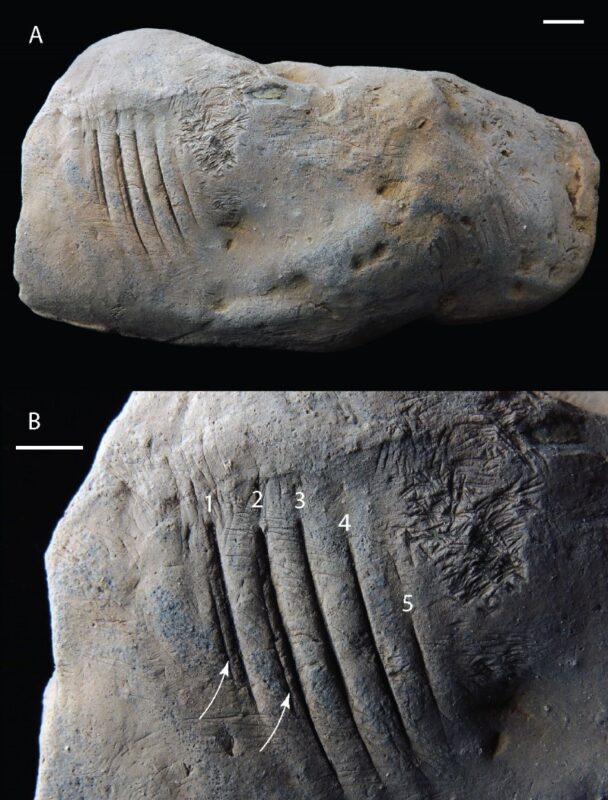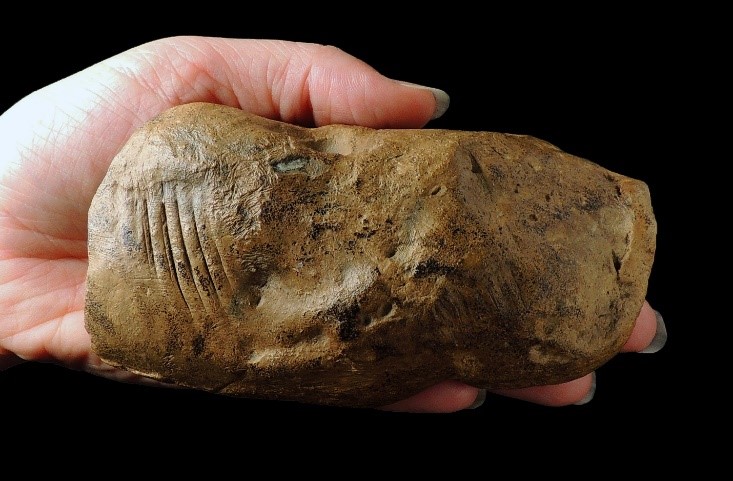
Figure 2. The fossilized gar-bitten crocodile poop. A. Full view of the coprolite showing the five bold tooth raking marks over one end. B. Close-up look at the tooth bite marks. The bold furrows are numbered 1-5. Notice the two white arrows pointing to fine tooth marks made by small teeth situated along the edge of the gar jaws. To the right of numbers 4 and 5, notice the fine nibble marks made by some other organism that was actually grazing on the poop before it became fossilized. In this figure, the coprolite was temporarily lightly coated with a white powder to improve contrast and detail. The white bars are 1 cm in length.
Have you ever regretted having bitten something? The equivalent of fish-brain regret probably went through the mind of the prehistoric fish that bit squish. In this instance, the squish was fresh crocodile poop that the fish mistook for a delectable meal!
The evidence of this poor-judgment encounter is preserved in a fossilized poop (i.e., a coprolite) that includes the fish-tooth raking marks over its curved surface (Figures 1 & 2). An international team of paleontologists describes this saga in an open-access paper published recently in Ichnos.
Remarkably, poop can fossilize, especially poop from carnivores like crocodiles because as they ingest their bony prey, the minerals in the bones of their prey predispose and improve the very slim chance that the carnivore’s poop will fossilize. From the diameter of the poop, it came from an extinct croc that was about 11 feet long
The fossilized poop is a trace fossil. Trace fossils are the preserved evidence of the activity of a once-living organism. The fish bite marks are also trace fossils, so this is an exceedingly rare example of a trace fossil on a trace fossil, making it a composite trace fossil.
The sucker-punched fish that bit the squish was a gar that lived in a shallow marine environment about 16 million years ago in what is now the State of Virginia, U.S.A. Gars are ram feeders that hunt by slowly stalking their prey until their jaws are close to the prey, at which time, the gar very rapidly moves its head and snaps its jaws shut to grab its prey.
What probably happened was that the settling poop attracted the attention of the gar, which it misidentified as prey. It maneuvered into striking distance and snap (Figure 3)! The glancing bit was enough for the gar’s brain to register “inedible;” it did not eat any more of the croc poop. Following the bite, the poop settled to the ocean floor, was entombed by fine sediment and became fossilized, preserving the evidence of the bad day for the gar.
Remarkably, there are organisms that eat poop regularly, a valuable habit that has been going on for hundreds of millions of years. On the crocodile coprolite, notice the dense cluster of tiny feeding gouge marks in Figure 2B to the right of the long gar tooth bite marks. It is not known what kind(s) of animal(s) was nibbling the feces before it fossilized. It is a very good thing that some animals eat and recycle poop because without that happening, we would be buried in the stuff.
Online link to the paper at: (https://www.tandfonline.com/doi/epdf/10.1080/10420940.2023.2182300?needAccess=true&role=button)
Explore how the prehistoric past, natural environments, and maritime heritage come to life and tell a unique story of the Chesapeake Bay. The Calvert Marine Museum is open daily from 10 a.m. to 5 p.m. Admission is $11.00 for adults; $9.00 for seniors, military with valid I.D, AAA and AARP members; $6.00 for children ages 5 – 12; children under 5 and museum members are admitted free. For more information about the museum, upcoming events, or membership, visit the website at www.calvertmarinemuseum.com or call 410-326-2042. Follow us on Facebook, Instagram, and Twitter.

Figure 1. The 16 million-year-old fossilized gar-bitten crocodile poop. The gar tooth marks are the curving gouges that course across the left end of the coprolite.

Figure 2. The fossilized gar-bitten crocodile poop. A. Full view of the coprolite showing the five bold tooth raking marks over one end. B. Close-up look at the tooth bite marks. The bold furrows are numbered 1-5. Notice the two white arrows pointing to fine tooth marks made by small teeth situated along the edge of the gar jaws. To the right of numbers 4 and 5, notice the fine nibble marks made by some other organism that was actually grazing on the poop before it became fossilized. In this figure, the coprolite was temporarily lightly coated with a white powder to improve contrast and detail. The white bars are 1 cm in length.


